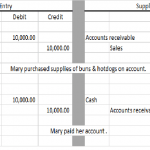
Reconciling the accounts is a particularly important activity for businesses and individuals because it is an opportunity to check for fraudulent activity and to prevent financial statement errors. Reconciliation is typically done at regular intervals, such as monthly or quarterly, as part of normal accounting procedures. By prioritizing reconciliation in accounting, lawyers and law firms can maintain financial accuracy and compliance, but that doesn’t mean that lawyers need to spend hours each day looking at accounts on paper or in Excel. By leveraging technology for more efficient reconciliation processes, lawyers can save time and greatly reduce the chance of error. The goal of bank reconciliation is to check that ending balances match on both your bank statement and your records.
Businesses that follow a risk-based approach to reconciliation will reconcile certain accounts more frequently than others, based on their greater likelihood of error. These articles and related content is the property of The Sage Group plc or its contractors or its licensors (“Sage”). Please do not copy, reproduce, modify, distribute or disburse without express consent from Sage.These articles and related content is provided as a general guidance for informational purposes only. These articles and related content is not a substitute for the guidance of a lawyer (and especially for material requirements planning questions related to GDPR), tax, or compliance professional.

Keeping your accounts reconciled is the best way to make sure that your balances are accurate and an important part of ensuring adequate financial controls are in place. While reconciling your bank statement, you notice the bank debited your account twice for $2,000 in error. For example, real estate investment company ABC purchases approximately five buildings per fiscal year based on previous activity levels. This year, the estimated amount of the expected account balance is off by a significant amount.
By adhering to these best practices, businesses can ensure their account reconciliation process is as efficient, accurate, and effective as possible, contributing to better financial management and decision-making. Any balance sheet accounts that have statements provided by sources external to the company, should be reconciled every month. The process of account reconciliation provides businesses with the opportunity to notify the bank (or other external source of statements) of errors and have them corrected. For example, a business might compare its cash account records (from its internal ledgers) with its monthly bank statement provided by its financial institution.
Reconciling to External Documentation
- Account reconciliation should be prepared and carried out by qualified accounting personnel, typically within the finance department.
- By leveraging technology for more efficient reconciliation processes, lawyers can save time and greatly reduce the chance of error.
- For the legal profession, however, regular, effective reconciliation in accounting is key to maintaining both financial accuracy and legal compliance—especially when managing trust accounts.
- Its powerful matching algorithms quickly identify and resolve variances, increasing speed and accuracy.
- General ledger reconciliation, where accountants check the accuracy of the company’s account balances at the end of an accounting period, ensures the accuracy of financial statements.
Accounting software automation and adding a procure-to-pay software, like Planergy, can streamline the process and increase functionality by automatically accessing the appropriate financial records. And while most financial institutions do not hold you responsible for fraudulent activity on your account, you may never know about that fraudulent activity if you don’t reconcile those accounts. While the reconciliation process remains the same, with two sets of documents compared for accuracy, the difference lies in what is being reconciled. Cash accounting is the easiest way to manage your accounting, flexible budget report and provides a better picture of your cash flow, but is only a suitable method for very small businesses. The accountant of company ABC reviews the balance sheet and finds that the bookkeeper entered an extra zero at the end of its accounts payable by accident. The accountant adjusts the accounts payable to $4.8 million, which is the approximate amount of the estimated accounts payable.
Types of Account Reconciliations
Some businesses create a bank reconciliation statement to document that they regularly reconcile accounts. This document summarizes banking and business activity, reconciling an entity’s bank account with its financial records. Bank reconciliation statements confirm that payments have been processed and cash collections have been deposited into a bank account. For lawyers, reconciliation in accounting is essential for ensuring that financial records are accurate, consistent, and transparent. While proper reconciliation is the standard for how law firms should handle all financial accounts, it is particularly important—and often required—for the management of trust accounts.
Common Examples of Account Reconciliation
Though you may not see the process if you’re using accounting software, because this is generally automated, if you enter a debit to an account you will have to enter a corresponding credit for the account to remain in balance. And, because Clio integrates with best-in-class accounting tools like QuickBooks and Xero, you can use them together to further simplify reconciliations. When using Clio together with these integrated accounting solutions, trust account updates made in Clio are then automatically updated in QuickBooks or Xero. Businesses are generally advised to reconcile their accounts at least monthly, but they can do so as often as they wish.
In both cases where mistakes are identified as a result of the reconciliation, adjustments should be undertaken in order for the account balance to match the supporting information. After scrutinizing the account, the accountant detects an accounting error that omitted a zero when recording entries. Rectifying the error brings the current revenue definition of ebit to $90 million, which is relatively close to the projection.
Investigate discrepancies
To do this, companies periodically reconcile their financial records with external documents. For example, a company may reconcile their general ledger and subledgers monthly with bank statements and vendor invoices. It is a general practice for businesses to create their balance sheet at the end of the financial year, as it denotes the state of finances for that period. However, you need to record financial transactions throughout the year in the general ledger to be able to put together the balance sheet. Account reconciliation is an important accounting process as the entries in the general ledger may not always be accurate. For instance, when you receive a check from a customer, you may have recorded it as paid.